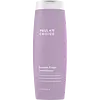What's inside
What's inside
 Key Ingredients
Key Ingredients

No key ingredients
 Benefits
Benefits

 Concerns
Concerns

No concerns
 Ingredients Side-by-side
Ingredients Side-by-side

Water
Skin ConditioningCetyl Alcohol
EmollientCyclopentasiloxane
EmollientBehentrimonium Chloride
PreservativeStearyl Alcohol
EmollientPhenyl Trimethicone
Skin ConditioningButylene Glycol
HumectantPanthenol
Skin ConditioningHydrolyzed Wheat Protein
Skin ConditioningGlycol Stearate
EmollientPolyquaternium-10
Citric Acid
BufferingDisodium EDTA
Phenoxyethanol
PreservativeChlorphenesin
AntimicrobialSorbic Acid
PreservativeWater
Skin ConditioningCetearyl Alcohol
EmollientC13-15 Alkane
SolventNeopentyl Glycol Diheptanoate
EmollientCetyl Palmitate
EmollientStearamidopropyl Dimethylamine
EmulsifyingBehentrimonium Chloride
PreservativeShea Butter Cetyl Esters
Skin ConditioningBisabolol
MaskingGlycerin
HumectantPolysorbate 80
EmulsifyingPolyquaternium-37
Citric Acid
BufferingHydrogenated Polydecene
EmollientDisodium EDTA
Ethylhexylglycerin
Skin ConditioningTrideceth-6
EmulsifyingTocopherol
AntioxidantPhenoxyethanol
PreservativeWater, Cetearyl Alcohol, C13-15 Alkane, Neopentyl Glycol Diheptanoate, Cetyl Palmitate, Stearamidopropyl Dimethylamine, Behentrimonium Chloride, Shea Butter Cetyl Esters, Bisabolol, Glycerin, Polysorbate 80, Polyquaternium-37, Citric Acid, Hydrogenated Polydecene, Disodium EDTA, Ethylhexylglycerin, Trideceth-6, Tocopherol, Phenoxyethanol
 Reviews
Reviews

Ingredients Explained
These ingredients are found in both products.
Ingredients higher up in an ingredient list are typically present in a larger amount.
This ingredient is a preservative and often used for it's anti-static properties. You'll most likely see this ingredient in hair conditioners.
It does not cause irritation or sensitization in leave-on products at 1-5%.
Citric Acid is an alpha hydroxy acid (AHA) naturally found in citrus fruits like oranges, lemons, and limes.
Like other AHAs, citric acid can exfoliate skin by breaking down the bonds that hold dead skin cells together. This helps reveal smoother and brighter skin underneath.
However, this exfoliating effect only happens at high concentrations (20%) which can be hard to find in cosmetic products.
Due to this, citric acid is usually included in small amounts as a pH adjuster. This helps keep products slightly more acidic and compatible with skin's natural pH.
In skincare formulas, citric acid can:
While it can provide some skin benefits, research shows lactic acid and glycolic acid are generally more effective and less irritating exfoliants.
Most citric acid used in skincare today is made by fermenting sugars (usually from molasses). This synthetic version is identical to the natural citrus form but easier to stabilize and use in formulations.
Read more about some other popular AHA's here:
Learn more about Citric AcidDisodium EDTA plays a role in making products more stable by aiding other preservatives.
It is a chelating agent, meaning it neutralizes metal ions that may be found in a product.
Disodium EDTA is a salt of edetic acid and is found to be safe in cosmetic ingredients.
Learn more about Disodium EDTAPhenoxyethanol is a preservative that has germicide, antimicrobial, and aromatic properties. Studies show that phenoxyethanol can prevent microbial growth. By itself, it has a scent that is similar to that of a rose.
It's often used in formulations along with Caprylyl Glycol to preserve the shelf life of products.
Water. It's the most common cosmetic ingredient of all. You'll usually see it at the top of ingredient lists, meaning that it makes up the largest part of the product.
So why is it so popular? Water most often acts as a solvent - this means that it helps dissolve other ingredients into the formulation.
You'll also recognize water as that liquid we all need to stay alive. If you see this, drink a glass of water. Stay hydrated!
Learn more about Water